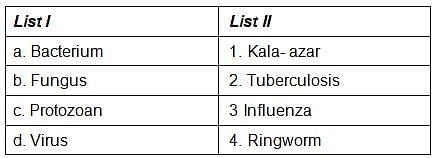SSC CGL Previous Year Questions: General Science - 14 - SSC CGL MCQ
30 Questions MCQ Test SSC CGL General Awareness Previous Year Papers (Topic-wise) - SSC CGL Previous Year Questions: General Science - 14
A cellulosic wall is found in the cells of (SSC CHSL 2013)
The filtration unit of kidney is (SSC CHSL 2013)
| 1 Crore+ students have signed up on EduRev. Have you? Download the App |
The nutritive tissue in the seeds of higher plants is known as (SSC CHSL 2013)
Yeast is an important source of (SSC CHSL 2013)
Heating of an ore below its melting point in the absence of air is known as (SSC CHSL 2013)
The most electronegative element among the following is (SSC CHSL 2013)
Mark the compound which possesses ionic, covalent and co-ordinate bonds. (SSC CHSL 2013)
The depletion of Ozone layer is mainly due to (SSC CHSL 2013)
Match correctly the infectious agents given in List I with the diseases caused by them given in List II : (SSC CHSL 2013)

Matter waves are (SSC CHSL 2013)
When the milk is churned vigorously the cream from it is separated out due to (SSC CHSL 2013)
Gas thermometers are more sensitive than the liquid thermometers because the gases (SSC CHSL 2013)
Which of the following is not caused by atmospheric refraction of light ? (SSC CHSL 2013)
Which one out of the following helps in burning (SSC Multitasking 2013)
In organic compounds, nitrogen is estimated by (SSC Multitasking 2013)
Master copy of genetic information is (SSC Multitasking 2013)
Contraceptive pills in the market contain (SSC Multitasking 2013)
Nematocysts are present in (SSC Multitasking 2013)
Which of the following micro-organisms is used in milk curdling? (SSC Multitasking 2013)
Which of the following is present in Chlorophyll molecule? (SSC Multitasking 2013)
When a body falls from an aeroplane, there is increase in its (SSC Multitasking 2013)
What does ‘Ozone Layer’ absorb? (SSC Multitasking 2013)
In a water lifting electric pump, we convert (SSC Multitasking 2013)
The type of mirror used in automobiles to see the traffic on the rear side is (SSC Multitasking 2013)
The hottest part of the gas flame is known as (SSC Multitasking 2013)
Which of the following radiations has the least wavelength? (SSC Multitasking 2013)
The earth is a (SSC Multitasking 2013)
BCG vaccination is given at the age of (SSC Multitasking 2013)
Which of the following atmospheric gases constitute greenhouse gases? (SSC Multitasking 2013)
- Carbon dioxide
- Nitrogen
- Nitrous oxide
- Water vapour
Select the correct answer using the codes given below.
|
25 docs|67 tests
|
|
25 docs|67 tests
|

















